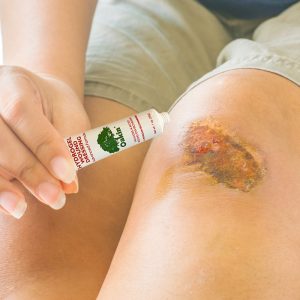Wound dressings created from local plants and vegetation were commonly used for the treatment of wounds in medical folklore dating back centuries. Then, as now, a major issue in caring for wounds involved the likelihood of infection. Bacteria can easily enter the body through broken or damaged skin and colonize wounds within the first 48 hours of injury; leading to infection and prolonging wound healing at best; or lead to more serious complications, including amputation and death4.
Topical antibiotic wound dressings, including Bacitracin and Neomycin, that are currently used in treating wounds contain antibiotics that are known contact allergens. Studies by Mordorski et al. concluded they have not been shown to decrease the risk of infections in wounds8. McDonnell6 found antibiotics are associated with adverse side effects including hypersensitivity, immune-suppression, and allergic reactions. The increased resistance to synthetic agents such as silver and bleach that fight harmful bacteria and the adverse effects antibiotics can have on the user have resulted in new research on antimicrobials of plant origin.
 Oak extract is abundant in nature and known to have a high concentration of tannins. Tannins play a role in wound healing by reacting with harmful bacteria and fungi that cause infection to inhibit their activity. In addition to their bacteria-killing properties, tannins exert anti-inflammatory properties and antioxidant effectiveness; helping to heal cuts, abrasions, wounds, burns, and other skin conditions 4 without the side effects often associated with antibiotics.
Oak extract is abundant in nature and known to have a high concentration of tannins. Tannins play a role in wound healing by reacting with harmful bacteria and fungi that cause infection to inhibit their activity. In addition to their bacteria-killing properties, tannins exert anti-inflammatory properties and antioxidant effectiveness; helping to heal cuts, abrasions, wounds, burns, and other skin conditions 4 without the side effects often associated with antibiotics.
Studies to determine the effectiveness of oak extract-based wound dressings demonstrate the ability to inhibit the growth of bacteria, including Staph aureus, making it useful for the treatment of skin infections. Tannins also assist in creating a protective layer that acts as a barrier to further infection1 2 3 5 7 9.
Oakin®, the proprietary ingredient in AMERIGEL® Hydrogel Wound Dressing, contains tannins from oak bark extract. These highly constricting natural compounds draw proteins to the wound, decrease cell wall permeability and exert anti-inflammatory and bactericidal properties to reduce the risk of infection while helping to heal wounds.
Podiatrists in an annual nationwide survey have named AMERIGEL Hydrogel Wound Dressing their top choice as a Topical Wound-Ulcer Treatment and Topical Wound Dressing Following Nail Surgery since 2003.
References
- BioScience Laboratories Inc. An Evaluation of One Test Product for its Antibacterial Properties When Challenged with Two Microorganism Strains Using an In-Vitro Time-Kill Method. 2005.
- Chung, KT, Lu Z, Chou MW. Mechanism of inhibition of tannic acid and related compounds on the growth of intestinal bacteria. Food and Chemical Toxicology. 1998; 36: 1053-60.
- Davis SC, Mertz PM. Determining the Effect of an Oak Bark Formulation on Methicillin-Resistant Staphylococcus Aureus and Wound Healing in Porcine Wound Models. Ostomy Wound Manage. 2008;54(10):16-8, 20, 22-5.
- Houghton PJ, Hylands PJ, Mensah, AY, Hensel A Deters AM. In vitro tests and ethnopharmacological investigations: wound healing as an example, Journal of Ethnopharmacology, 100: (1-2),100-107, 2005.
- Horvathova, Martina, et al. Effect of the French Oak Wood Extract Rovuvit on Markers of Oxidative Stress and Activity of Antioxidant Enzymes in Healthy Volunteers: A Pilot Study, Oxid Med Cell Longev., 2014;639868.
- McDonnell G, Russell AD. Antiseptics and disinfectants: activity, action, and resistance. Clin Microbiol Rev. 12: 147-179, 1999.
- Moore, J. Evaluating Antimicrobial Efficacy and Cost of 3 Dressings Containing Silver verses a Novel Antimicrobial Hydrogel Impregnated Gauze Dressing Containing Oakin, an Oak Extract. Advances in Skin & Wound Care: 2010; 23: (12) 544-551.
- Mordorski, Breanne BA, Friedman, Adam J MD, and Kircik, Leon H MD. Bensal HP for Second Intention Healing Following Mohs Micrographic Surgery or Shave Skin Biopsy: An Open-label Pilot Study. 2016;15(10).
- Sohretoglu D, Ekizoglu M, Kihc E, and Sakar, MK. Antibacterial and Antifungal Activities of Some Quercus Species Growing in Turkey. FABAD J Pharm. Sci., 2007:32, 127-130.hole Health Chicago. Oak Bark. Updated May 19, 2009.


